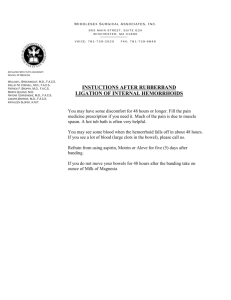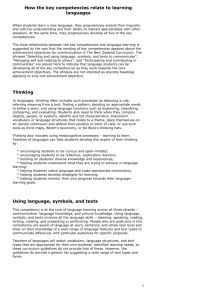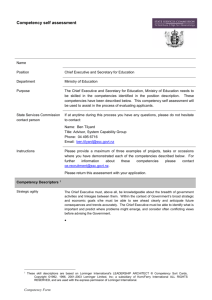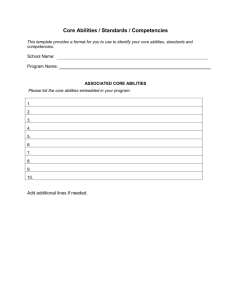Career Banding 101
advertisement
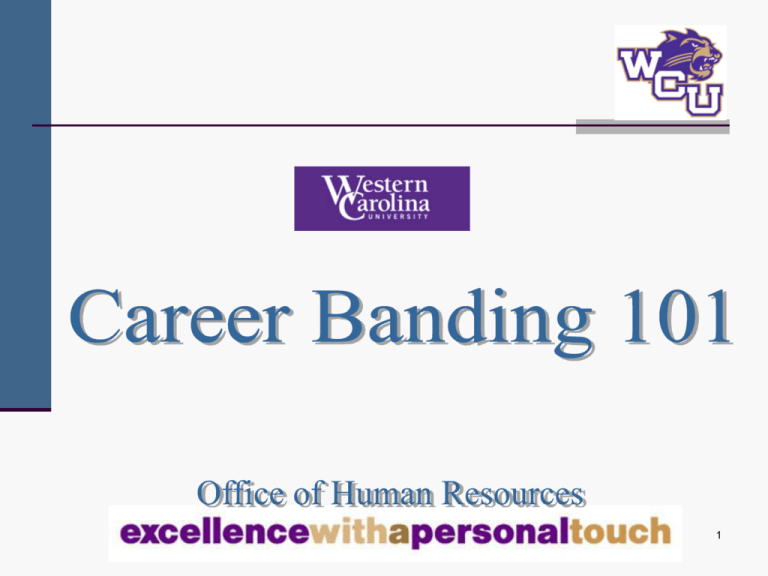
1 Objectives To provide a historical perspective on career banding To familiarize you with career banding terminology and career banding concepts To answer questions you may have regarding the career banding system 2 WCU Banding History IT and Law Enforcement Implemented 4/1/2006 Legislative Suspension enacted 7/1/2006 Flexibility to band all available bands WCU chose to band approx. 470 positions effective 2/1/2007 UNC System allowed to move forward 7/1/2007 All UNC System position implemented by 6/1/2008 3 The Career Banding System A human resources system that changed the way we classified positions, administered salary, and assessed and developed employees Consolidation of classification titles into bands Pay based on current market rates Management flexibility and responsibility in granting promotions, setting pay, and promoting career growth 4 Career Banding Structure Operations and Skilled Trades Job Family Banded Classes Facility Maintenance TechMechanical Facility Maintenance TechBuilding Vehicle/ Equipment Repair Tech Banded Classes Facility Maintenance Supervisor Vehicle/ Equipment Repair Super. Vehicle/ Equipment Operator Transportation Supervisor 5 What are competencies? Competencies are the observable and measurable set of: skills knowledge abilities key behaviors that are necessary to perform the job. 6 Position vs. Employee Business Need is determined by the position competency requirements Employee’s are assessed in relation to the business need Two levels must be determined through assessment The position level and employee level Employee level can not be higher than the position level 7 Contributing Competencies Position-Knowledge, skills, and abilities that are required for an entry level or basic position. Employee-Knowledge, skills, abilities, and work behaviors needed to successfully perform the requirements of a basic position. 8 Journey Competencies Position-Fully applied body of knowledge, skills, and abilities required for the position. Employee-Fully applied body of knowledge, skills, abilities, and work behaviors needed to successfully perform the requirements of a broad and moderately complex position. 9 Advanced Competencies Position-The highest and/or broadest scope of knowledge, skills, and abilities that are required for the position. Employee-The highest and/or broadest scope of knowledge, skills, abilities, and work behaviors needed to successfully perform the requirements of a specialized and complex position. 10 Competency Profile One for each banded class Description of Work Functional Competencies described at each level – Contributing, Journey, Advanced 11 Competency Profile Example - Facility Maintenance Technician, Building Trades Competency Contributing Journey Advanced Knowledge – Technical Performs a limited variety of recurring and related tasks/functions using easily understood steps/processes/functions/applications to perform corrective and preventive maintenance or construction of facilities. Provides technical assistance to others by troubleshooting simple facilities maintenance issues and determining their cause. More complex issues are typically referred to a higher level technician. Skilled at operating basic tools and equipment of assigned trade(s). Performs a variety of recurring and non-recurring tasks/functions. These tasks/functions may involve related or varying processes to test, renovate, overhaul, replace, and perform preventive maintenance on standard building systems. Provides technical assistance to others by troubleshooting standard facilities maintenance issues and determining their cause. Mentors other technicians. Routinely and consistently performs widely varying and broad, functionally diverse facility maintenance assignments requiring in-depth analysis and problem solving regarding the most complex, non-routine building systems, using advanced skills related to assigned trade area. Serves as a technical expert within the work unit. Guides, directs and coaches others regarding application and interpretation of technical issues. Applies and interprets technical knowledge to resolve unique or highly complex situations. Analyzes and researches appropriate solutions. Has a thorough and extensive understanding of programs, concepts and practices in the most complex building systems trades area as well as a general understanding of one or more different trades areas Attention to Detail Follows instructions through standard work-orders for assigned tasks. Performs routine or repetitious tasks completely and accurately. Checks work for mistakes before completion of tasks. Compares finished work to what is expected. Seeks approval of supervisor based upon complexity of task completed. Ensures all work meets and/or exceeds applicable codes and standards. Checks and re-checks work prior to, during, and after completion. Ensures that all parts of a project/task are completed. Uses appropriate record keeping methods. Checks and re-checks work of others considering accuracy with respect to standards and codes. Considers options and details that are not obvious. Troubleshoots total systems. Integrates highest quality control standards into work. 12 Pay Factors: 3. Financial Resources Appropriate Market Rate Internal Pay Alignment 4. Required Competencies 1. 2. 13 Salary Structure Career banding uses a Market Pay Structure Statewide Market rates have been researched and implemented by OSP WCU has adopted the statewide market rates Rates correspond to Competency levels Rates have been established for each career band. 14 Management’s Role Keep position descriptions current Ensure career banding concept is communicated to employees Assess the business need of the position you supervise independent of the employee Evaluate employee’s initial competency level Evaluate competencies on an on-going basis Discuss competency level with employees 15 Management’s Role (cont’d.) Provide detailed documentation for band/level placement and salary adjustments-Online employment system Establish career development plans and coaching that should enhance an employee’s contribution to the organization’s success. Use new career banding processes for recruitment and selection. Apply pay factors equitably-HR maintains salary approval responsibility 16 Rater Bias Positions and Employees should be assessed objectively for skill requirements and skill set without any impact from the rater biases listed below Horns effect Halo effect Stereotyping Recency effect Leniency effect Strictness effect 17 Expected Agency’s Distribution Manage to Journey level Very few Advanced Journey Contributing Advanced 18 Thank You!

